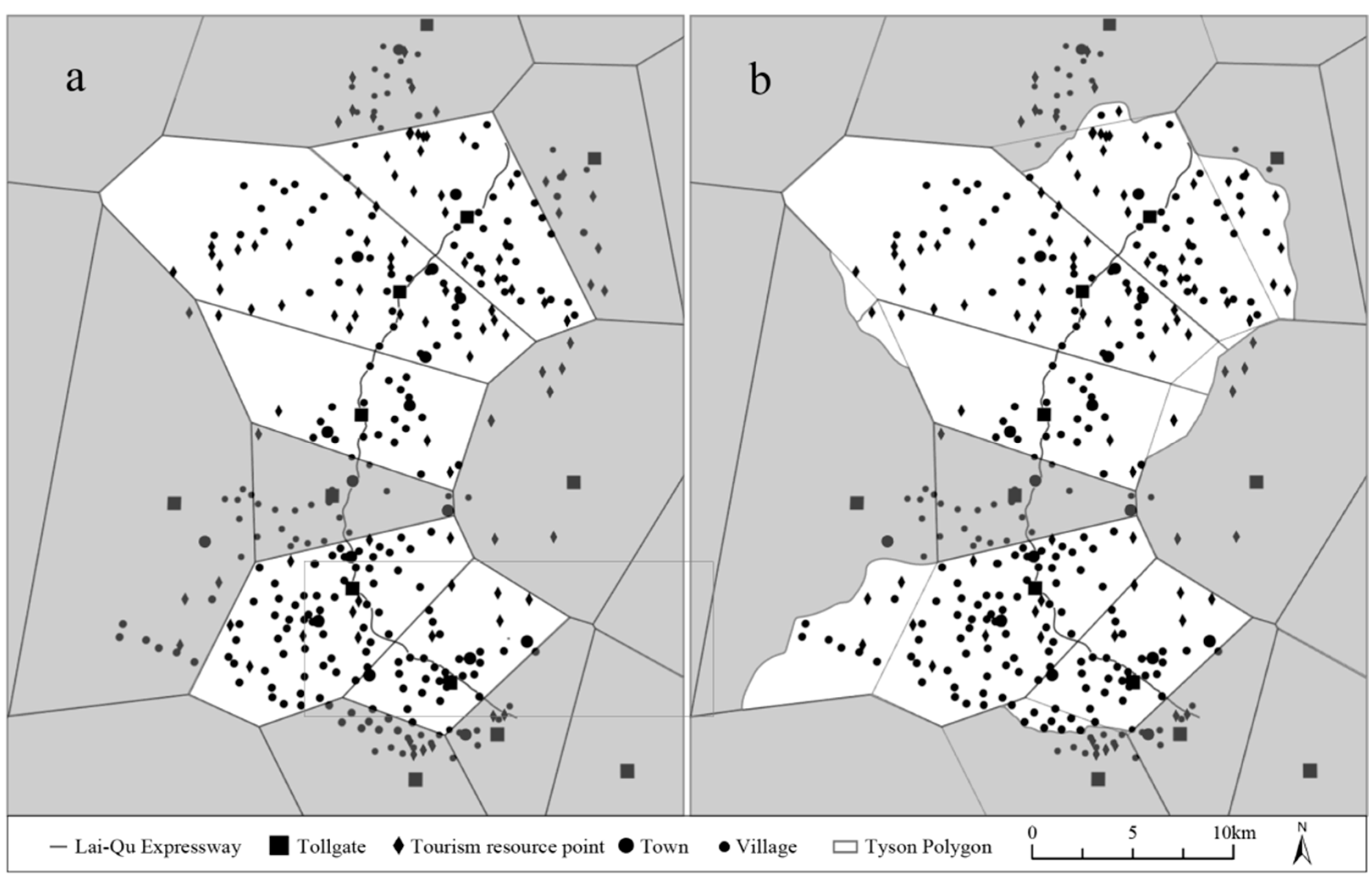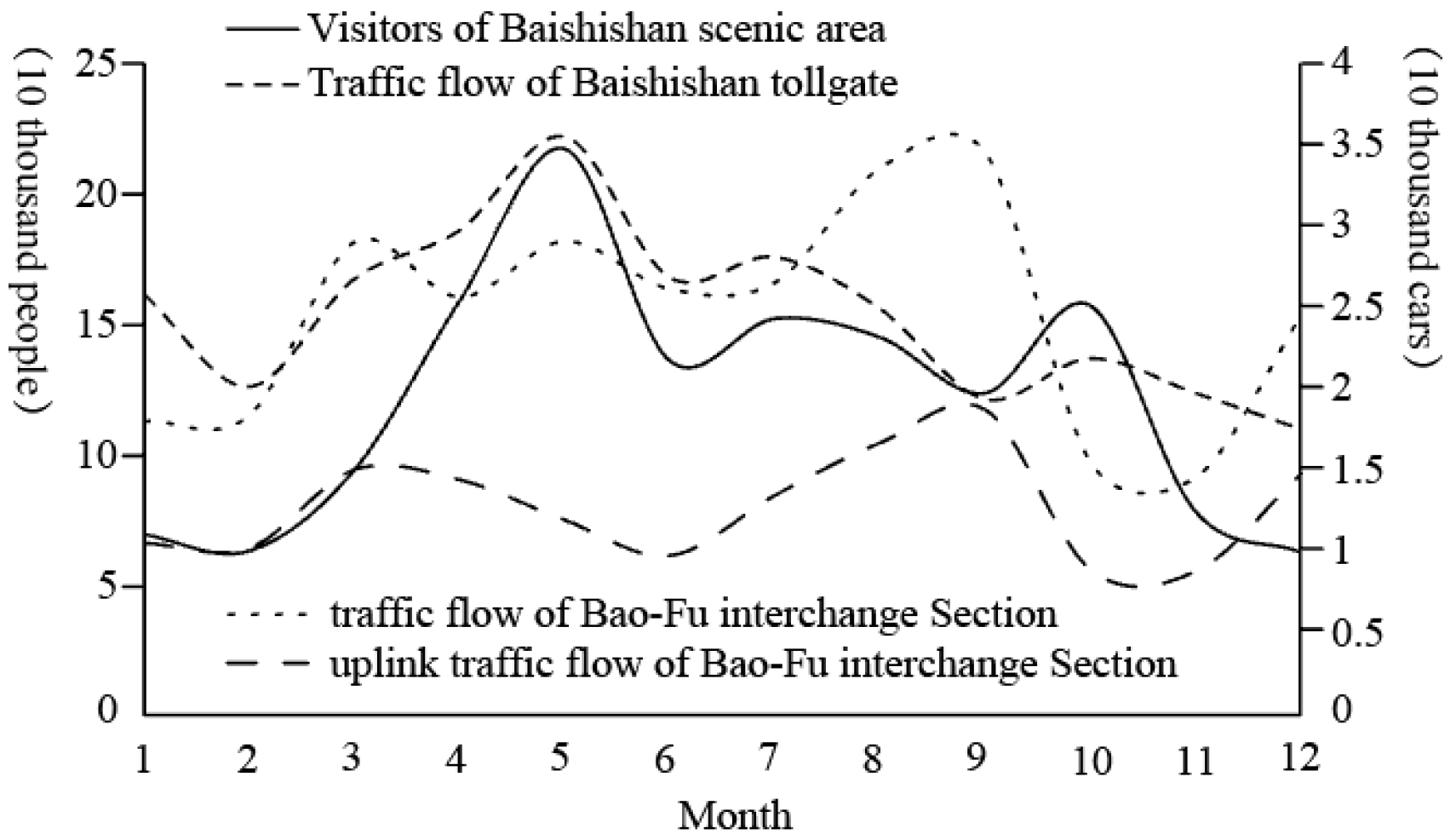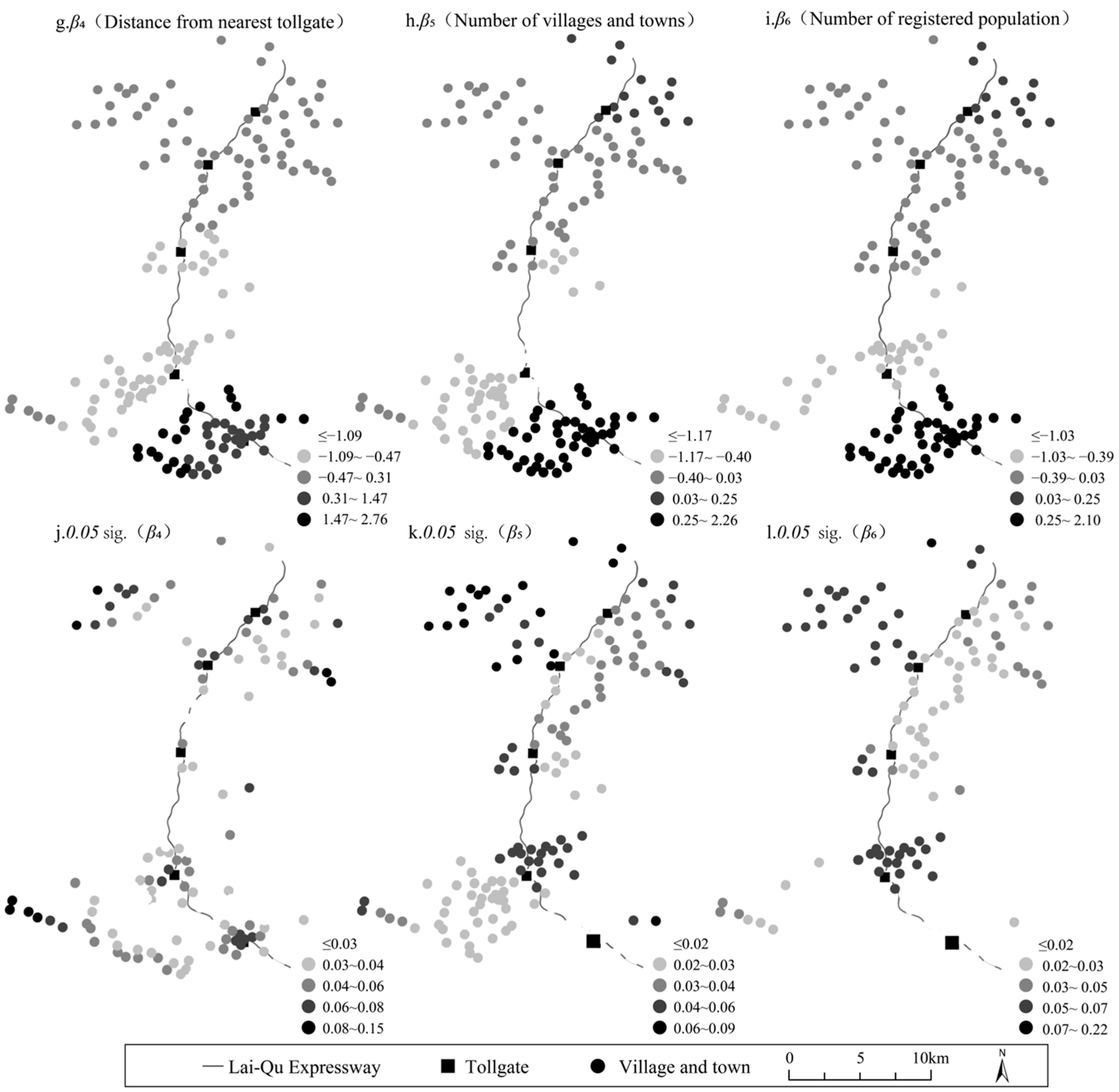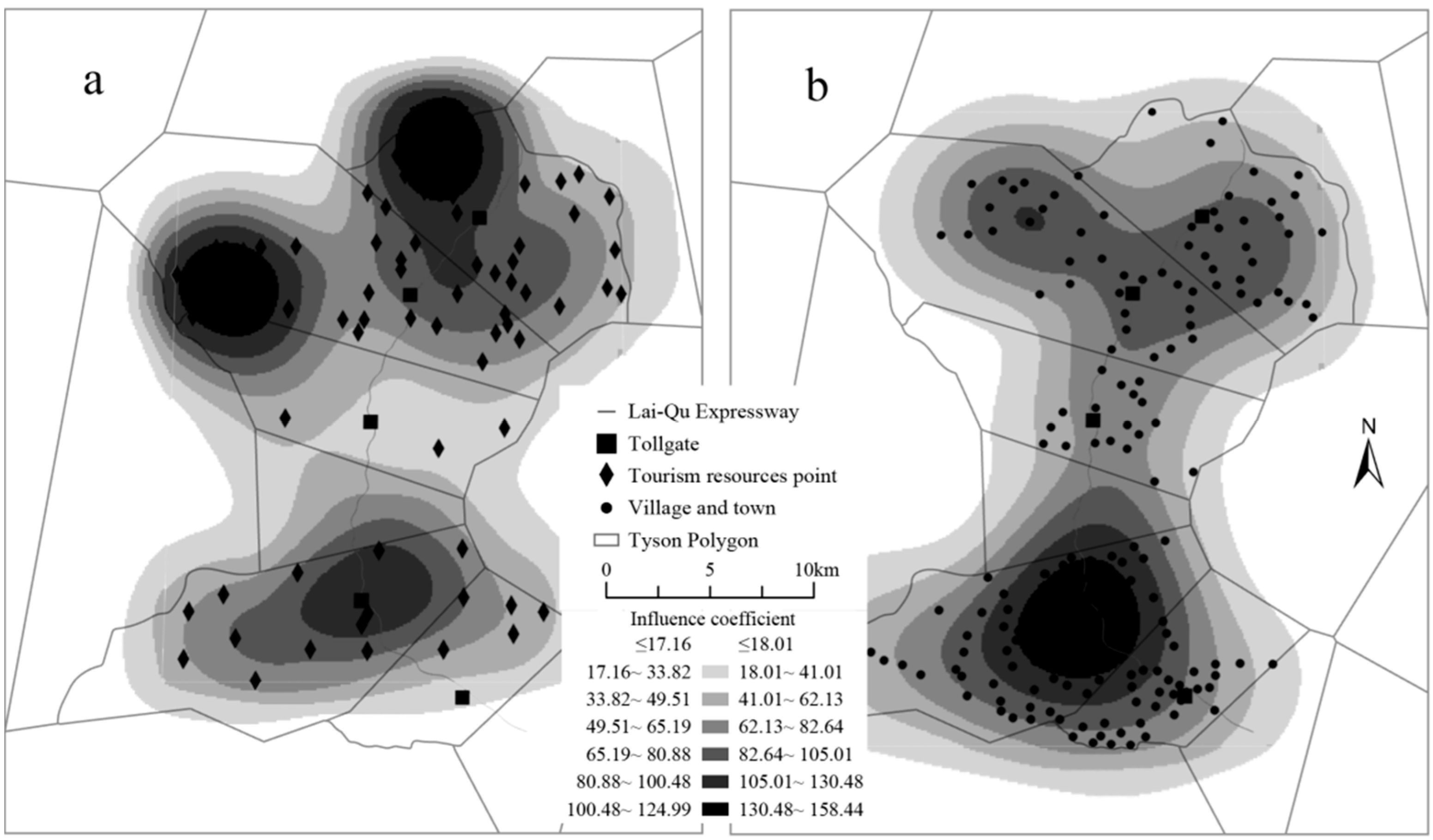Traffic–Tourism Spatial Interaction of Lai-Qu Expressway Based on the Traffic Flow Data
Abstract
1. Introduction
2. Theoretical Basis and Research Methods
2.1. Theoretical Basis
2.2. Research Methods
3. Case Area and Data
4. Results
4.1. The Correlation Between Lai-Qu Expressway Traffic Flow and Tourist Flow of the Scenic Spots
4.2. The Correlation Between Toll Charges and Regional Development Index
4.3. Characteristics of Tourism Spatial Impact of Lai-Qu Expressway
4.3.1. Characteristics of Spatial Influence of Traffic Flow on Tourism Resource Points
4.3.2. Characteristics of Spatial Influence of Traffic Flow on Residential Area
4.3.3. The Interactive Characteristics of Traffic–Tourism Space
5. Conclusions and Discussion
- (1)
- The influence space of high-speed transportation extends along with the newly built expressway, and realizes the spatial interaction between transportation and tourism in the process of overlapping of the transportation-affected space and regional tourism space, which provides new opportunities and possibilities for regional tourism, and will also promote the change in the regional tourism spatial pattern and agglomeration form of tourism resources.
- (2)
- The peak–valley value data of the Baishishan Tollgate traffic flow and Baishishan Scenic Spot tourist flow almost simultaneously show that they are directly correlated. The GWR results of tourism resource points show that the grade of tourism resource points () has the greatest impact and the strongest significance on the traffic flow of the Lai-Qu Expressway. In the interaction between the traffic and tourism space, it is shown that the northern section of the Lai-Qu Expressway is expected to form a high-grade and high-density tourism resource agglomeration area.
- (3)
- The traffic flow of the Lai-Qu Expressway has the strongest correlation with the number of residential areas (). The results of the GWR of residential areas show that the number of residential areas () has the greatest impact on the traffic flow at each tollgate of the Lai-Qu Expressway, but the most significant explanatory variable is the distance between settlements and the nearest tollgate (); that is, the impact of residential areas on the traffic flow of the Lai-Qu Expressway is obviously attenuating with distance, which is most typical in the Lingshannan Tollgate.
- (4)
- The interaction map of the transportation–tourism space of the Lai-Qu Expressway is calculated by the fuzzy density calculation method and the GWR results shows that it is expected to form a spatial pattern of two tourism resource cluster centers and one sub-center, and one residential cluster center and one sub-center under the influence of the Lai-Qu Expressway. The distance attenuation curve shows that the tollgates in the northern section of the Lai-Qu Expressway are associated with a large number of tourism resource points, and the transportation–tourism spatial interaction extends the spatial impact of the Lai-Qu Expressway. A large number of residential areas associated with the southern section of the Lai-Qu Expressway slows down the distance attenuation effect, and the interaction between traffic and residential areas extends the spatial influence of the Lai-Qu Expressway.
- (1)
- With regard to the research on the spatial interaction of transportation and tourism at a small scale and a small sample size, this paper adopts the form of eigenvalue sampling similar to that in statistics, that is, to compare and analyze the traffic flow of the Baishishan Scenic Spot and the traffic flow data of the Baishishan Tollgate, to obtain the interaction between regional transportation and tourism development. The evaluation method of the tourism efficiency and high-speed traffic coordination degree provided by Guo et al. [25] can also better reflect the regional transportation–tourism interaction and spatial interaction, but this method is not adopted in this paper. The reason is that this method is more suitable for a large-scale and multi-sample analysis, and needs the support of multiple regional development statistics. And the analytical method for the spatial interaction between transportation and tourism under small-scale spatial and limited sample conditions, as proposed in this study, demonstrates a greater suitability for county-level spatial planning and tourism policy formulation. In other words, this approach internalizes externalities such as transportation networks, regional policies, and ecological development into regional development “responses” [26]. The findings offer practical cases for enhancing transportation networks and optimizing regional spatial development.
- (2)
- With regard to the positioning of residential areas in the study of the transportation–tourism spatial interaction and the development of regional tourism destinations, many achievements of the social exchange theory generally believe that communities (residential areas) play an important role in regional tourism development [19,20]. Considering the regional conflict of functional–structural space units and the dynamic space–time evolution of the “production–ecological” space in territorial spatial planning, the boundary between scenic spots and communities in areas where tourism resources are concentrated becomes more unclear. Therefore, this paper also tends to regard residential areas as the elements to be considered in regional tourism development under the guidance of social exchange theory. Residential areas can serve regional tourism development from the aspects of characteristic dwellings, labor force, infrastructure construction, and so on. Simultaneously, the regional development role of the Lai-Qu Expressway is “optional” rather than “alternative”. Under the framework of the social exchange theory, this perspective integrates external factors (including transportation network integrity and policy coordination between tourism and ecological development) into a comprehensive regional development framework. This integration enables a holistic analysis of the expressway’s regional impacts, making the methodology better suited to small-scale spatial contexts for transportation planning and evaluation, as well as tourism strategy development.
- (3)
- With regard to the construction of tourism resource agglomeration areas and regional tourism destinations, with the opening up of newly built highways and the continuous effect on regional tourism development, the status quo of the “isolated island” development and integrated development of low-concentration industries will be broken, and replaced by the organic series of scattered tourism resources, the contiguous development of tourism resources along highways, and the development of cross-administrative region boundaries. For example, in the research results of this paper, the northern section of the Lai-Qu Expressway may form two tourism resource agglomeration centers. Gao et al. [24] mentioned in their research on tourism agglomeration areas in Hebei Province that the formation of agglomeration areas needs the support of traffic conditions and takes high-level scenic spots as the core attraction of agglomeration areas. As time goes on, the influence of the Lai-Qu Expressway on the development of the regional tourism industry and the spatial pattern of tourism will be more obvious.
Author Contributions
Funding
Data Availability Statement
Conflicts of Interest
References
- Van, N.; Shimizu, T. The effect of transportation on tourism promotion: Literature review on application of the Computable General Equilibrium (CGE) Model. Transp. Res. Procedia 2017, 25, 3096–3115. [Google Scholar]
- Palhares, L. The role of transport in tourism development: Nodal functions and management practices. Int. J. Tour. Res. 2003, 5, 403–407. [Google Scholar] [CrossRef]
- Huang, T.; Xi, J.; Ge, Q. Spatial differentiation and integration optimization of an urban agglomeration tourism system under the influence of high-speed railway network evolution. Appl. Spat. Anal. Policy 2019, 12, 349–376. [Google Scholar] [CrossRef]
- Fisher, M.; Wood, A.; Roh, H.; Kim, C.K. The geographic spread and preferences of tourists revealed by user-generated information on Jeju Island, South Korea. Land 2019, 8, 73. [Google Scholar] [CrossRef]
- Park, B.; Nunkoo, R.; Yoon, Y.S. Rural residents’ attitudes to tourism and the moderating effects of social capital. Tour. Geogr. 2015, 17, 112–133. [Google Scholar] [CrossRef]
- Nunkoo, R.; Ramkissoon, H. Developing a community support model for tourism. Ann. Tour. Res. 2011, 38, 964–988. [Google Scholar] [CrossRef]
- Kanwal, S.; Rasheed, I.; Pitafi, H.; Pitafi, A.; Ren, M. Road and transport infrastructure development and community support for tourism: The role of perceived benefits, and community satisfaction. Tour. Manag. 2020, 77, 104014. [Google Scholar] [CrossRef]
- Novianti, S.; Fauzi, C.; Suhartanto, D. Spatial analysis of tourist dispersal and mobility for tourism destination planning and development: A case study of great ocean road region, Australia. IOP Conf. Ser. Mater. Sci. Eng. 2020, 830, 032081. [Google Scholar] [CrossRef]
- Best, K. Highways and Lifeways: Highway 11 and the Shaping of the Ways of Life and Senses of Place of Nature-Based Tourism Operators in South-Central Almaguin, Ontario, Canada; University of Northern British Columbia: Prince George, BC, Canada, 2016. [Google Scholar]
- Ishikura, T.; Yoshikawa, H.; Yokoyama, F. Spatial economic impacts of ring road highway development in Greater Tokyo Area. In Proceedings of the 22nd Annual Conference on Global Economic Analysis, Warsaw, Poland, 19–20 June 2019; pp. 1–16. [Google Scholar]
- Lee, J. Conflict mapping toward ecotourism facility foundation using spatial Q methodology. Tour. Manag. 2019, 72, 69–77. [Google Scholar] [CrossRef]
- Lin, R.; Chen, K. Design and Research of Traffic-Tourism Integration Service System Based on Scenario Theory. In International Conference on Green Intelligent Transportation System and Safety; Springer Nature: Singapore, 2022; pp. 539–548. [Google Scholar]
- Feng, B. Coupling and coordinated development of traffic accessibility and regional tourism economy. Res. Transp. Bus. Manag. 2023, 49, 101010. [Google Scholar] [CrossRef]
- Ravazzoli, E.; Streifeneder, T.; Cavallaro, F. The effects of the planned high-speed rail system on travel times and spatial development in the European Alps. Mt. Res. Dev. 2017, 37, 131–140. [Google Scholar] [CrossRef]
- Bai, L.; Lu, Z.; Gao, Y.; Gao, W. Study on Spatial Pattern of Regional Tourism under Influence of High-Speed Tourism Corridor: Case Study of Taihang Mountain Expressway. J. Highw. Transp. Res. Dev. 2021, 15, 102–110. [Google Scholar] [CrossRef]
- Masson, S.; Petiot, R. Can the high speed rail reinforce tourism attractiveness? The case of the high speed rail between Perpignan (France) and Barcelona (Spain). Technovation 2009, 29, 611–617. [Google Scholar] [CrossRef]
- Ali, L.; Mi, J.; Shah, M.; Khan, A.; Imran, M. Transport culture akin to the China-Pakistan economic corridor. Hum. Syst. Manag. 2017, 36, 381–396. [Google Scholar] [CrossRef]
- Sun, F.; Jia, Y. Influence factors of residents’ political trust from perception of tourism community residents: Based on explanation of social exchange theory. J. Beijing Inst. Technol. (Soc. Sci. Ed.) 2020, 22, 90–99. (In Chinese) [Google Scholar]
- Gursoy, D.; Chi, G.; Dyer, P. Locals’ attitudes toward mass and alternative tourism: The case of Sunshine Coast, Australia. J. Travel Res. 2010, 49, 381–394. [Google Scholar] [CrossRef]
- Kanwal, S.; Pitafi, H.; Rasheed, I.; Pitafi, A.; Iqbal, J. Assessment of residents’ perceptions and support toward development projects: A study of the China-Pakistan Economic Corridor. Soc. Sci. J. 2022, 59, 102–118. [Google Scholar] [CrossRef]
- Brunsdon, C.; Fotheringham, S.; Charlton, M. Geographically weighted regression. J. R. Stat. Soc. 1998, 47, 431–443. [Google Scholar] [CrossRef]
- Yu, H.; Wang, Q.; Zhang, B.; Liu, J. Driving mechanism and the spatial differentiation of coupling coordinated development of tourism supply and demand in China. Sci. Geogr. Sin. 2020, 40, 1889–1898. (In Chinese) [Google Scholar]
- Napitupulu, D.; Rahmaitria, F.; Rosita, R. The Effect of tourism accessibility perception towards tourists visiting intention to Toba lake in samosir district. J. Indones. Tour. Hosp. Recreat. 2021, 4, 39–52. [Google Scholar] [CrossRef]
- Gao, W.; Zhang, Q.; Lu, Z.; Wu, D.; Du, X. Modelling and application of fuzzy adaptive minimum spanning tree in tourism agglomeration area division. Knowl.-Based Syst. 2018, 143, 317–326. [Google Scholar] [CrossRef]
- Guo, X.; Mu, X.; Ding, Z.; Ming, Q. The coordination pattern of tourism efficiency and high-speed transportation: A case study of 41 cities in the Yangtze River Delta. Geogr. Res. 2021, 40, 1042–1063. (In Chinese) [Google Scholar]
- Du, X.; Li, Z.; Bai, L.; Pan, L. Navigating sustainable development: Empirical analysis of corporate social responsibility, eco-friendly production, and stakeholder green commitment through the lens of stakeholder theory. Sustain. Dev. 2024, 32, 4250–4260. [Google Scholar] [CrossRef]






| Name of Tollgate | Total Annual Traffic Flow | Annual Entrance Traffic Flow | Annual Export Traffic Flow | Total Annual Tolls | Location of Section Point | Section Traffic Flow |
|---|---|---|---|---|---|---|
| Baishishan | 306,714 | 116,556 | 190,158 | 6,549,596.79 | Yansuya interchange | / |
| Chuanli | 171,197 | 70,434 | 100,763 | 2,458,500.18 | Bao-Fu interchange | 85,062 |
| Gubeiyue | 88,184 | 28,845 | 59,339 | 2,340,639.21 | Dongwang interchange | 90,151 |
| Lingshannan | 280,674 | 109,371 | 171,303 | 2,823,291.08 | ||
| Quyangbei | 1,536,680 | 623,367 | 913,313 | 33,133,209.25 |
| Name of Tollgate | Number of Tourist Resource Points | Number of Villages | Number of Township-Level Settlements | Overview of Township-Level Settlements | |||||
|---|---|---|---|---|---|---|---|---|---|
| The Serial Number | Area | Number of Village Committees | The Registered Population | Enterprise Number | Number of General Stores | ||||
| Baishishan | 29 | 29 | 2 | 1 | 5930 | 25 | 33,720 | 6 | 69 |
| 2 | 6802 | 25 | 33,215 | 4 | 32 | ||||
| Chuanli | 29 | 31 | 4 | 3 | 12,120 | 35 | 70,123 | 50 | 107 |
| 4 | 5039 | 14 | 9889 | 0 | 0 | ||||
| 5 | 5400 | 17 | 40,404 | 0 | 22 | ||||
| 6 | 9200 | 14 | 12,230 | 5 | 22 | ||||
| Gubeiyue | 6 | 18 | 2 | 7 | 9700 | 23 | 23,327 | 45 | 27 |
| 8 | 11,800 | 22 | 17,204 | 0 | 20 | ||||
| Lingshannan | 12 | 69 | 2 | 9 | 10,300 | 8 | 4328 | 0 | 9 |
| 10 | 23,200 | 21 | 14,502 | 24 | 4 | ||||
| Quyangbei | 5 | 34 | 3 | 11 | 15,700 | 20 | 19,546 | 26 | 50 |
| 12 | 10,100 | 14 | 8961 | 3 | 22 | ||||
| 13 | 5723 | 14 | 26,720 | 356 | 29 | ||||
| January | February | March | April | May | June | July | August | September | October | November | December | Total | |
|---|---|---|---|---|---|---|---|---|---|---|---|---|---|
| Baishishan Tollgate | 2.67 | 2.08 | 2.77 | 3.08 | 3.68 | 2.78 | 2.91 | 2.58 | 2.00 | 2.26 | 2.04 | 1.81 | 30.67 |
| Baishishan Scenic Area | 7.08 | 6.43 | 9.67 | 16.42 | 22.52 | 14.04 | 15.72 | 14.98 | 12.74 | 16.25 | 8.03 | 6.38 | 150.26 |
| a | b | c | d | |
|---|---|---|---|---|
| a | / | / | / | / |
| b | 0.737/0.006 | / | / | / |
| c | 0.312/0.323 | 0.416/0.179 | / | / |
| d | −0.030/0.092 | 0.105/0.746 | 0.860/0.000 | / |
| Entrance Traffic Flow | Export Traffic Flow | Export Passenger Cars | Export Vans | Total Export Charges | Export Passenger Car Charges | Export Van Charges | |
|---|---|---|---|---|---|---|---|
| Number of village committees | 0.769/0.129 | 0.753/0.141 | 0.795/0.108 | 0.724/0.166 | 0.715/0.175 | 0.871/0.055 | 0.687/0.200 |
| The registered population | 0.728/0.163 | 0.725/0.165 | 0.897/0.039 | 0.656/0.229 | 0.641/0.243 | 0.841/0.074 | 0.609/0.276 |
| Area | −0.296/0.696 | −0.305/0.618 | −0.356/0.557 | −0.282/0.646 | −0.249/0.687 | −0.310/0.612 | −0.238/0.700 |
| Number of enterprises | −0.141/0.696 | −0.238/0.700 | 0.056/0.929 | −0.326/0.593 | −0.333/0.585 | −0.090/0.886 | −0.361/0.551 |
| Number of general stores | 0.563/0.323 | 0.557/0.329 | 0.788/0.113 | 0.472/0.422 | 0.466/0.429 | 0.720/0.170 | 0.428/0.472 |
Disclaimer/Publisher’s Note: The statements, opinions and data contained in all publications are solely those of the individual author(s) and contributor(s) and not of MDPI and/or the editor(s). MDPI and/or the editor(s) disclaim responsibility for any injury to people or property resulting from any ideas, methods, instructions or products referred to in the content. |
© 2025 by the authors. Licensee MDPI, Basel, Switzerland. This article is an open access article distributed under the terms and conditions of the Creative Commons Attribution (CC BY) license (https://creativecommons.org/licenses/by/4.0/).
Share and Cite
Gao, Y.; Bai, L.; Liu, S.; Zheng, H.; Liu, J.; Cheng, J.; Yao, H.; Zhao, Q. Traffic–Tourism Spatial Interaction of Lai-Qu Expressway Based on the Traffic Flow Data. Land 2025, 14, 1197. https://doi.org/10.3390/land14061197
Gao Y, Bai L, Liu S, Zheng H, Liu J, Cheng J, Yao H, Zhao Q. Traffic–Tourism Spatial Interaction of Lai-Qu Expressway Based on the Traffic Flow Data. Land. 2025; 14(6):1197. https://doi.org/10.3390/land14061197
Chicago/Turabian StyleGao, Yujian, Long Bai, Shengqiang Liu, Hongjuan Zheng, Jie Liu, Jinxiang Cheng, Haiyuan Yao, and Qing Zhao. 2025. "Traffic–Tourism Spatial Interaction of Lai-Qu Expressway Based on the Traffic Flow Data" Land 14, no. 6: 1197. https://doi.org/10.3390/land14061197
APA StyleGao, Y., Bai, L., Liu, S., Zheng, H., Liu, J., Cheng, J., Yao, H., & Zhao, Q. (2025). Traffic–Tourism Spatial Interaction of Lai-Qu Expressway Based on the Traffic Flow Data. Land, 14(6), 1197. https://doi.org/10.3390/land14061197





